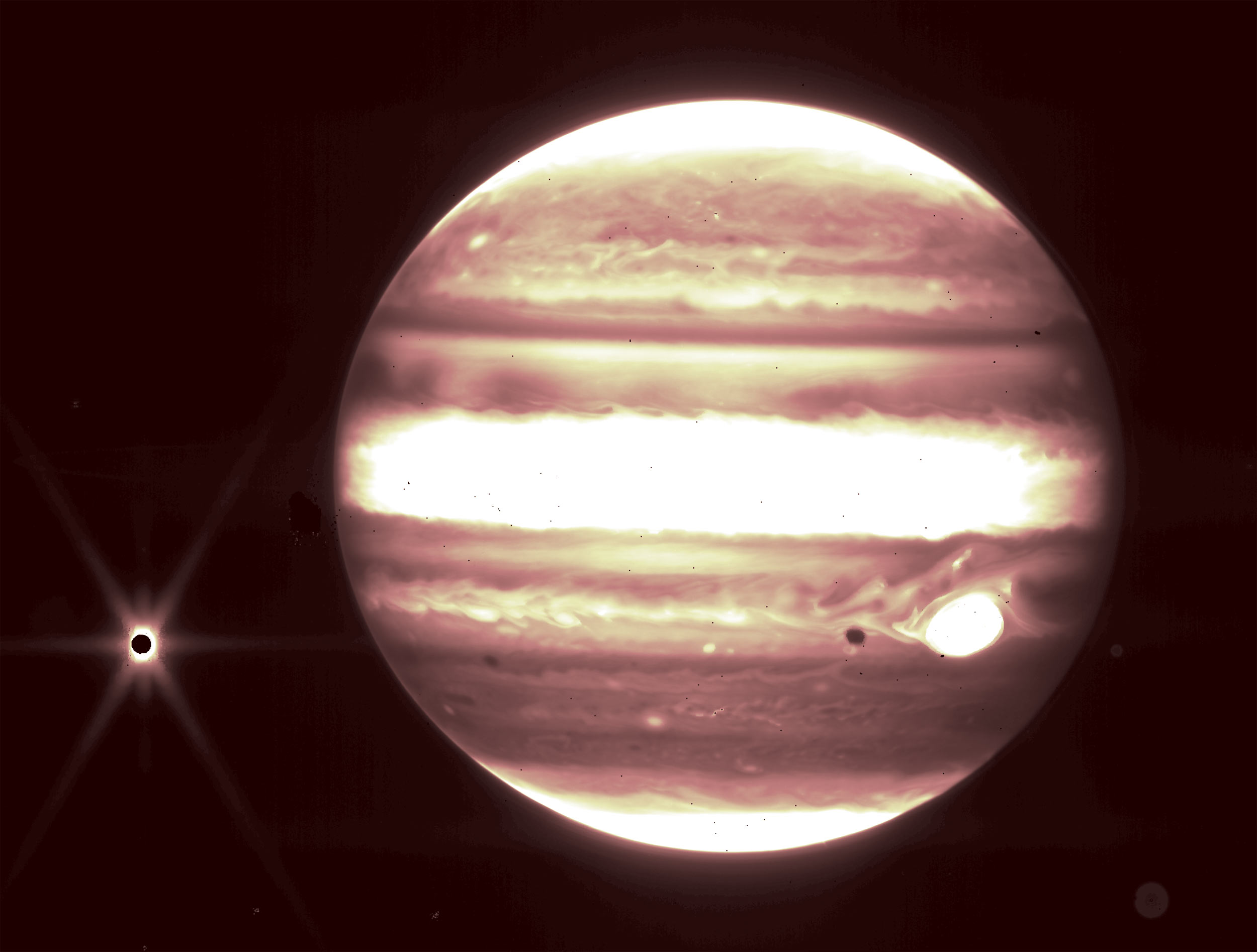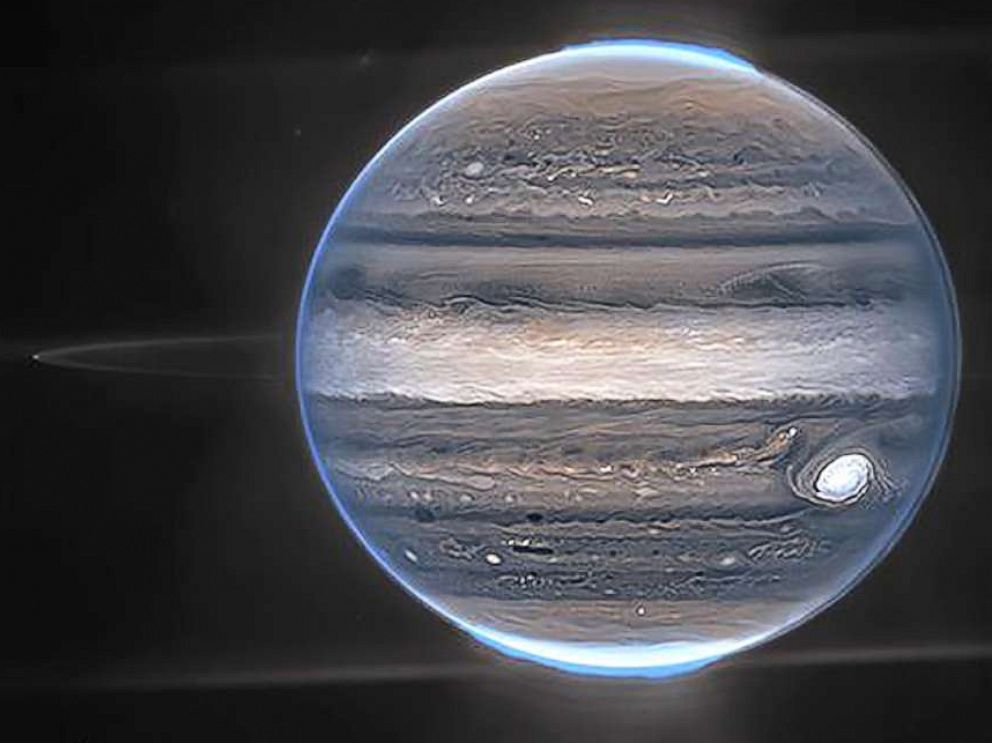NASA’s James Webb Space Telescope Illuminates Solar System’s Mysteries: Unveils Enigmatic Moons Ganymede and Io in Breathtaking Detail
NASA’s James Webb Space Telescope reveals new insights into Jupiter’s moons Ganymede and Io, demonstrating its versatility beyond galaxies, showcasing cutting-edge technology, and uncovering unique phenomena, enriching our cosmic understanding.

NASA’s James Webb Space Telescope mesmerizes with stunning images, expanding its scope beyond distant galaxies to unveil secrets of our solar system, recently revealing Ganymede and Io’s mysteries and highlighting its versatility and potential for groundbreaking science. (PHOTO: Sci.News)
READ ALSO: CLOSER LOOK: MIKE MADIGAN TRIAL COMMENCES AMIDST LEGAL PROCEEDINGS AND ALLEGATIONS
James Webb Space Telescope Transcends Boundaries: Revealing Jupiter’s Moons Ganymede and Io, Unveiling Solar System’s Mysteries
NASA’s James Webb Space Telescope continues to captivate the world with its awe-inspiring images, unveiling celestial wonders in the deep expanse of the universe. According to NASA, the James Webb Space Telescope’s capabilities are not confined to distant galaxies alone; it has now shifted its gaze towards objects within our very own solar system, offering unique perspectives on familiar celestial bodies. In a remarkable feat, the James Webb Space Telescope has recently shared new images of two of Jupiter’s moons, Ganymede and Io, in a revelation that adds to our understanding of these enigmatic worlds.
The report stated that these new images from the James Webb Space Telescope are a product of spectroscopic and infrared technology. The groundbreaking insights were brought forth by a collaborative effort between researchers from the University of California, Berkeley and Cornell University, as they shared their findings in two peer-reviewed papers: one published in Science Advances on July 21, 2023, and the other in JGR Planets on July 18, 2023.
While the primary focus of the James Webb Space Telescope lies in studying distant galaxies and stars, it has demonstrated its versatility by turning its attention to our neighboring planets and moons. Notably, the James Webb Space Telescope has investigated not only Jupiter but also other celestial bodies like Saturn, Uranus, Neptune, Enceladus, and comets. Imke de Pater from the University of California, Berkeley, remarked that these observations showcase the James Webb Space Telescope’s potential to yield groundbreaking science, even when observing bright objects like Jupiter or faint subjects situated in its vicinity, as reported.
READ ALSO: ST PAUL SHOOTING INCIDENT: COMMUNITY GATHERS FOR CANDLELIGHT VIGIL HONORING 12-YEAR-OLD MARKEE JONES
Ganymede’s Magnetic Secrets Unveiled: Hydrogen Peroxide Presence Discovered by James Webb Space Telescope
According to SkyNews, one of the groundbreaking revelations is centered on Ganymede, Jupiter’s largest moon and the only one boasting a magnetic field. Samantha Trumbo of Cornell University spearheaded the Ganymede study, which unveiled the presence of hydrogen peroxide at the moon’s poles. This discovery was attributed to radiolysis, a process triggered by charged particles colliding with ice at the poles. These charged particles, channeled by Ganymede’s magnetic field, significantly influence the surface chemistry of its polar caps, revealing a phenomenon comparable to Earth’s auroras.
The report further stated, Io, Jupiter’s highly volcanic moon, took center stage in another study. James Webb Space Telescope’s observation of ongoing eruptions at specific locations on Io, particularly Loki Patera and Kanehekili Fluctus, illuminated the unique features of these volcanic events. The presence of sulfur monoxide (SO) emissions, a result of forbidden transitions in Io’s sulfur dioxide (SO2) atmosphere, was a noteworthy discovery. This revelation, occurring under specific conditions such as Jupiter’s shadow, offered the first conclusive link between excited sulfur monoxide and volcanic activity, debunking previous theories of ‘stealth volcanoes.’
In essence, NASA’s James Webb Space Telescope continues to amaze as it enriches our understanding of the cosmos. The recent revelations about Ganymede and Io provide remarkable insights into these celestial bodies, demonstrating the James Webb Space Telescope’s unparalleled capacity to unravel the mysteries of both the distant universe and our very own solar system.
READ ALSO: THE ULTIMATE GUIDE ON HOW TO BUILD A CRYPTO TRADING BOT AND UNLEASH THE FUTURE







































Pingback: Escalating Tensions Amidst US Involvement in Yemen: Houthi-Led Government Warns US Navy Against Territorial Waters Approach – Building Crypto
Pingback: Bold Vision: Humans on Venus by 2050 – OceanGate’s Co-Founder Unveils Ambitious Plan Amidst Titan Disaster Aftermath – Building Crypto